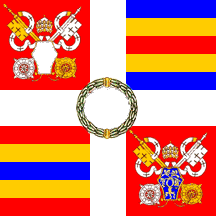
Basic Pattern
image by António Martins-Tuválkin, 7 June 2005

Last modified: 2006-03-18 by martin karner
Keywords: vatican | holy see | swiss guard | vatican guard | catholic |
Links: FOTW homepage |
search |
disclaimer and copyright |
write us |
mirrors

Basic Pattern
image by António Martins-Tuválkin, 7 June 2005
On this page:
See also:
The Papal Swiss Guard was founded in 1506. It is today largely
ceremonial, but like the Guards in London they are a fully
operational modern military force. When in ceremonial 16th
century uniform, they keep their firearms in guard boxes nearby.
The Papal Guard are the only mercenary unit permitted under Swiss
law since 1859, and are the last of a long tradition of a million
mercenaries in the world's armies. The Guard today consists of 5
officers, 25 NCOs and 70 halberdiers.
You can see a photo of recruits
swearing in on the Guards flag at <www.christusrex.org>.
I don't know when the flag was instituted, or how it has evolved,
but it represents the 18th century tradition of Swiss mercenary
flags. It consists of a white cross "traversante"
(extending to the edges, unlike the modern short Swiss cross)
which conveniently divides the flag into brightly coloured
quarters. The first and fourth quarters are identical and consist
of the Pope's arms on a red field. Presumably these change on the
Swiss Guards' flag with every new pope. The second and third
quarters are also identical, consisting of five horizontal
stripes -- blue-yellow-red-yellow-blue. (These are the colours of
the Guards' Renaissance-style uniform, which incidentally dates
from 1915, and was not designed by Michelangelo as the popular
myth would have us believe.) The central device on the white
cross is probably the arms of the colonel of the regiment, or
those of the Pfyffer d'Altishofen family which made the colonelcy
hereditary from 1652 to 1847. I'm not sure what the rules are for
changing the central coat of arms.
The colour photo represents the annual swearing in of recruits on
6 May (and the Guard's principal ceremonial event). This is the
anniversary of the 1527 sack of Rome when the 200-strong Guard
defended Pope Clement VII against a Spanish-German army of
22,000. 147 were killed (including the Captain Kaspar Roist of
Zurich), and the survivors took the Pope to Castel San Angelo
where they held out for a month before negiotiating a surrender.
Ironically Zurich was in the throws of the Reformation and had
recalled the Captain and his fellow Zurichers. They decided to
wait until the storm blew over, and paid for it with their lives.
T.F. Mills, 6 May 1998
The following is paraphrased and condensed from the article on
the Swiss Guards in the New Catholic Encyclopedia:
"From the time of the Middle Ages, Swiss pikemen fought as
mercenaries in the armies of many European states under treaties
with the various Swiss cantons. Among the most famous of
these were the Garde Suisse of the French monarchy.
Swiss soldiers served the armies of the Papacy from the late
1300s onward, but only during the reign of Julius II (1503-13)
was action taken to establish an organized unit of Swiss Guards
directly under the Pope. In 1505, pursuant to a treaty was
signed between Pope Julius II and the cantons of Zurich and
Lucerne, Julius requested that the two cantons send 200 soldiers
to Rome under the command of Peter von Hertenstein as condottiere
and Caspar von Silenen as captain. They arrived on January
21, 1506, and were taken into service with a papal blessing in
St. Peter's Square. That event is considered to be the date
of establishment of the Vatican's corps of Swiss Guards, the
"Cohors pedestris Helvetiorum a sacra custodia
Pontificis." This unit is the only modern survival of
the Swiss mercenary tradition, as the Swiss Constitution of 1874
prohibits the enlistment of Swiss citizens in the forces of
foreign powers with the exception of the Holy See.
Joe McMillan , 28 Febuary 2000
Quoting from The Banner of the Papal Swiss Guard by Walter
Angst in The Flag Bulletin, 187, May-June 1999
"only unmarried Swiss males of the Catholic faith -
historically, mainly from the four original Swiss cantons (Uri,
Schwyz, Unterwalden, Luzern) and Valais - are eligible for
serviece. Moreover, they must all be between 19 and 30
years of age, at least 174 cm tall and must have fulfilled their
basic military training in the Swiss Army. They are
privately contracted for this special Foreign Service for at
least two years. No official is openly involved in the
process, but usually the discreet services of some parish priests
are used. Guard duty includes the bodyguard for the
pontiff, the watch at the entrances to the city, the ceremonial
honor guard, security at many religious and diplomatic functions,
as well as information, surveillance, and similar service. The
commander of the Swiss Guard is always a colonel. He
belongs to the "pontifical family," holding the rank of
a "Chamberlain of His Holiness." The pope alone
appoints the commander. At present, the colonel commands a
lieutenant colonel, a guard chaplain, a major, a captain, a
master sergeant, four sergeants, 10 corporals, 10 vice-corporals,
and 70 halberdiers. This makes up the Guard of 100 men, although
in 1971 this force had dwindled to only 40 members. By law
the Guard can be composed of at most 100 volunteers; hence it is
called Hundertschweizer - (one hundred Swiss.)
"Unlike the regiments of the former military Foreigh Service
(which remained at times under the laws of the Swiss
Confederation), the Swiss Guard is under the pope who, throughthe
secretary of state of the Vatican, exercises far-reaching
jurisdiction over his 100 Swiss. The Guards must live
inside the walled city of the Vatican and they are considered
citizens of the Vatican State during their years of active
service. Since the Second Vatican Council, their famed
steel breast-armor is normally worn only on one special
ceremonial occassion - the yearly swearing-in ceremony of new
Guards, which takes place on 6 May."
The Flag Bulletin shows also the current flag of the Swiss guard,
divided into Four quarters by the Swiss cross. This flag
changes with every pope and with the commander of the Swiss
Guard. Therefore, the arms of Pope John Paul II in the
first quarter on a red background, horizontal stripes of blue,
yellow, red, yellow and blue in the second quarter, horizontal
stripes of red, yellow, blue, yellow and red in the third quarter
and the arms of Pope Julius II are in the fourth quarter on a red
background and centered on the cross the arms of the current
commander withing a green wreath.
Angst quotes 189 Swiss Guards who were at the 1527 sacking of
Rome, of which 147 perished. When the Germans invaded Rome
in 1944, the Swiss Guard stationed themselves in military grey
uniform, behind machine guns and mortars just in case.
Phil Nelson , 29 Febuary 2000
Above is an image of the Swiss Guard flag, . The flag is
2 meters square or a bit larger. The gray area on the
center inside the wreath is where the commander's arms are shown,
placed on a background of the colors of his native canton.
Joe McMillan, 29 Febuary 2000
Looking at the Swiss Guards flag as illustrated above, and
comparing it with the text, I see that according to the text the
arms in the first and fourth quarters are the same. However, in
your illustration, the arms in the first quarter are those of
John Paul II, while those in the fourth quarter show a tree.
Also, there is mention of a coat of arms in the centre (which is
shown in the photograph of guardsmen swearing allegiance), but
there's just a grey centre to the wreath in the illustration.
Mike Oettle, 19 December 2001
The difference with the photo, as far as I can tell, is in the
Coat of Arms on the center of the cross and the size of the
achievements in the first and fourth quarters. The Coat of
Arms in the fourth quarter is not visible in the photo at the
link, except for the tiara and keys, and is therefore not
inconsistent with the image. As to the gray area on the
center, note what Phil Nelson wrote above: "This flag
changes with every pope and with the commander of the Swiss Guard
... centered on the cross the arms of the current commander
withing a green wreath" and my note: "The gray
area on the center inside the wreath is where the commander's
arms are shown, placed on a background of the colors of his
native canton."
The arms of Pope John Paul II in the first quarter on a red
background ... and the arms of Pope Julius II are in the fourth
quarter on a red background."
Joe McMillan, 19 December 2001
Recently I ran across a website with some excellent photos of
Swiss Guard flags, including the most recent, at <www.schweizergarde.info>.
A PDF of the definitive Swiss Guard history, which contains
information on the history of the Guards' flags, is also
available there through a link: Paul Krieg, "Die
Schweizergarde in Rom," p. 446-449. He states
that the current Guards' flag design dates from the tenure of
commander Jules Repond (1910- 1921).
Rev. William M. Becker, 20 April 2005
This design exists since the early 20th cent. Above is a
tamplate with voided papal and commander arms, plus the Pope
Julius II's arms on the lower fly.
António Martins-Tuválkin, 7 June 2005
Considering only those Colonels after 1905 (when the current Vatican Swiss Guard flag pattern was designed) and the popes from the same period, we can list all flags that (theoretically) existed:.
1997-1998
It is possible that Estermann was not represented by a
flag with his Coat of Arms since he served as commander for less
than one day. He was appointed 4 May 1998, and murdered by one of
his men a few hours later New recruits were to be sworn in on 6
May 1998 in the famous flag ceremony (the anniversary of the sack
of Rome in 1527 when 147 Swiss Guards died protecting Pope
Clement VII), and Estermann had been acting commander since
October 1997 when his predecessor resigned, so it is also
possible that a new flag was ready for 6 May, or even unveiled on
4 May.
T.F. Mills, 9 June 2005
Here is the list of Commandants with their canton of origin
1. von Silenen, Kaspar UR (1506-1517)
2. Röist, Markus ZH (1518-1524)
3. Röist, Kaspar ZH (1518-1527)
vacant (1527-1548)
4. von Meggen, Jost LU (1548-1559)
5. von Silenen, Kaspar Leo LU (1559-1564)
6. Segesser von Brunegg, Jost LU (1566-1592)
7. Segesser von Brunegg, Stephan Alexander LU (1592-1629)
8. Flekenstein, Nikolaus LU (1629-1640)
9. Flekenstein, Jost LU (1640-1652)
10. Pfyffer von Altishofen, Johann Rudolf LU (1652-1657)
11. Pfyffer von Altishofen, Ludwig LU (1658-1686)
12. Pfyffer von Altishofen, Franz LU (1686-1696)
13. Mayr von Baldegg, Johann Kaspar LU (1696-1704)
vacant (1704-1712)
14. Pfyffer von Altishofen, Johann Konrad LU (1712-1727)
15. Pfyffer von Altishofen, Franz Ludwig LU (1727-1754)
16. Pfyffer von Altishofen, Jost Ignaz LU (1754-1782)
17. Pfyffer von Altishofen, Franz Alois LU (1783-1798)
vacant (1798-1800)
18. Pfyffer von Altishofen, Karl Leodegar LU (1800-1834)
19. Pfyffer von Altishofen, Martin LU (1835-1847)
20. Meyer von Schauensee, Franz Xaver Leopold LU (1848-1860)
21. von Sonnenberg, Alfred LU (1860-1878)
22. de Courten, Louis-Martin VS (1878-1901)
23. Meyer von Schauensee, Leopold LU (1901-1910)
24. Repond, Jules FR (1910-1921)
25. Hirschbühl, Alois GR (1921-1935)
26. von Sury d’Aspremont, Georg SO (1935-1942)
27. Pfyffer von Altishofen, Heinrich LU (1942-1957)
28. Nünlist, Robert LU (1957-1972)
29. Pfyffer von Altishofen, Franz LU (1972-1982)
30. Buchs-Binz, Roland FR (1982-1997)
31. Estermann, Alois LU (1998-1998)
32. Segmüller, Pius SG (1998-2002)
33. Mäder, Elmar Theodor SG (2002-)
T.F. Mills, 8 June 2005
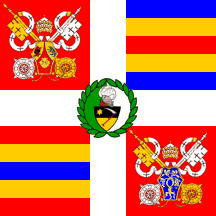
Swiss Guard Colors for Benedict XVI
image by António Martins-Tuválkin, 9 May 2005
.gif)
Detail (Arms of Guard Commandant Elmar Theodor Mäder)
image by António Martins-Tuválkin, 25 April 2005
Here is the new Swiss
Guard flag from <story.news.yahoo.com>.
Zachary Harden, 6 May 2005
The image is simply shown the expected new version of the
Papal Guard flag: I.e., identical to the previous Swiss
Guard Colors for John Paul II but with Benedict XVI's arms
replacing John Paul II's. Note that the side areas of the shield
are both or, and the central one is gules, whereas previously
sent images shown different color patterns. The photo shown
clearly the same central Coat of Arms too.
António Martins-Tuválkin, 9 May 2005
See also: Vatican (Holy See) - Personal Flag and Arms of Benedict XVI
Here are the Pontifical Swiss Guard colors for Popes Pius IX (obverse and reverse), Pius X, and John Paul II. I
photographed them about 1984 during a personal tour of the Swiss
Guard barracks. At that time, as you can see, the
current Swiss Guard flag was displayed in the Captain Commander's
office against the wall. It is paraded for the annual
swearing-in ceremony of new recruits each May, and perhaps a few
other occasions. On Vatican flag-flying days it is
displayed inside the "Bronze Doors," which lead from
St. Peter's Square to the Apostolic Palace via Cortile San
Damaso. With the death of John Paul II, it will now
have to be replaced by a flag bearing the arms of the new pope.
Rev. William M. Becker, 4 April 2005
Arms of Pius X (together with the arms of Julius II) were part
of the Swiss Guard's arms for the 400th anniversary in 1906. See
<www.schweizergarde.info>.
James Dignan, 26 April 2005
The other arms are the arms of Pope Julius II, who founded the
Swiss Guard in 1505. See <members.tripod.com>
located by António.
Santiago Dotor, 25 April 2005
The terrible Giuliano Della Rovere (1443-1513, Pope Julius II
in 1503) was more a warlord than a church man. He was elected
after the shortest conclave ever, in less than one day, after
having bought his election (which was admitted at that time).
Julius II reestablished the political power of the
papacy in Italy and set up the Cambrai League against Venice in
1508, then the Holy League against France (1511-1512). His
attempt of reforming the church during the Vth Council of Latran
(1512) was not successful. Julius II was a patron and appointed
the architect Bramante (1444-1514), who designed the Belvedere
Courtyard and started the St. Peter's Basilica (1505); the
painter, architect and sculptor Michelangelo Buonarotti
(1475-1564), who made for the Pope's grave the two slaves
(1513-1516) kept today in the Louvre Museum in Paris; and the
painter Raffaello Sanzio (1483-1520), who painted frescos in the
"rooms" of the Vatican and a famous portrait of the
Pope, kept today in the Offici Museum in Florence.
The Della Rovere family is a famous Italian family. The movie
director Roberto Rossellini (1906-1977) portrayed a descendant of
the family member of the anti-fascist resistance and killed by
the German forces in the movie "Il Generale Della
Rovere" (1959). The name of Rovere recalls the oak,
therefore the canting arms of the family. The Latin classical
word "robur" evolved to "roborem", and gave
the Provencal word '"rover" and the French words
"roure" and "robre", today
"rouvre". However, botanists, as usual, complicated the
situation, and it seems that "Quercus robur" is now the
pedunculated oak ("chene pédonculé"), whereas the
"chene rouvre" has been reallocated to species "Q.
petrae". The roots "roure" and "rouvre"
have given several toponyms in France (Roure, Le Rouret, Rouvray,
Grosrouvre...).
Ivan Sache, 28 April 2005
Flags has never existed. Pius X had completely rejected the
flag draft. Repond presented the draft of the new flag design
already in the year1912 . The pope Pius X was not open to the new
ideas.
António Martins-Tuválkin, 9 June 2005
1913-1914

Rejected - With the Arms of Guard Commandant Jules Repond
image by Jens Pattke, 19 February 2006
Upper hoist: arms of Pius X; Center:
Jules Repond, on black-white background (for Fribourg
/ Freiburg).
Source: <www.schweizergarde.info>.
Jens Pattke, 19 February 2006
1914-1921

With the Arms of Guard Commandant Jules Repond
image by Jens Pattke, 19 February 2006
Upper hoist: arms of Benedictus
XV; Center: Jules Repond, on black-white background
(for Fribourg / Freiburg).
Source: re-construction.
Jens Pattke, 19 February 2006
1935-1939
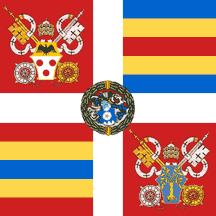
With the Arms of Guard Commandant Georg von Sury d'Aspremont
image by Jens Pattke, 20 February 2006
upper hoist: arms of Pius XI center: arms of Georg von Sury
d'Aspremont, on red- white background (for Solothurn).
Jens Pattke, 20 February 2006
1939-1942
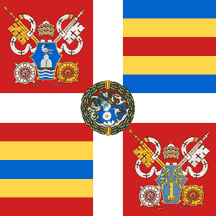
With the Arms of Guard Commandant Georg von Sury d'Aspremont
image by Jens Pattke, 20 February 2006
Upper hoist: arms of Pius XII. Center: arms of Georg von Sury
d'Aspremont, on red- white background (for Solothurn).
Jens Pattke, 20 February 2006
1942-1957
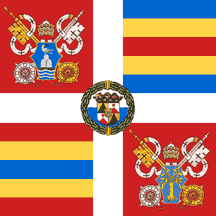
With the Arms of Guard Commandant Heinrich Pfyffer von Altishofen
image by Jens Pattke, 20 February 2006
Upper hoist: arms of Pius XII. Center: arms of Heinrich
Pfyffer von Altishofen, on white-blue background (for Luzern).
Source: <www.chateau-de-penthes.ch>,
Jens Pattke, 20 February 2006
1957-1958
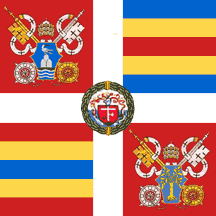
With the Arms of Guard Commandant Robert Nünlist
image by Jens Pattke, 23 January 2006
Upper hoist: arms of Pius XII. Center: arms of Robert
Nünlist, on white-blue background (for Luzern).
Source: <www.schweizergarde.info>.
Jens Pattke, 23 January 2006
1958-1963
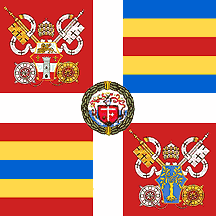
With the Arms of Guard Commandant Robert Nünlist
image by Jens Pattke, 23 January 2006
Upper hoist: arms of John XXIII. Center: arms of Robert
Nünlist, on white-blue background (for Luzern).
Source: <www.schweizergarde.info>.
Jens Pattke, 23 January 2006
1963-1972
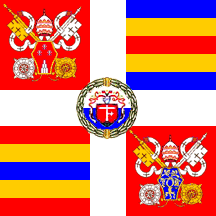
With the Arms of Guard Commandant Robert Nünlist
image by António Martins-Tuválkin, 12 June 2005
At <www.schweizergarde.info>
this one is shown at the bottom (at the top of the page the
2002-2005 flag is shown). Not the differences in the tiara and at
the tips of the estole, with red instead of the current golden.
(Perhaps this was changed at the same time as the wreath around
the central area?).
António Martins-Tuválkin, 12 June 2005
1978
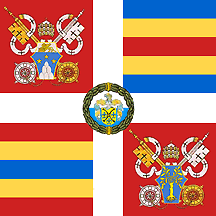
Unconfirmed !!!
With the Arms of Guard Commandant Franz Pfyffer von Altishofen
image by Jens Pattke, 11 June 2005
The usage of this flag of the Swiss Guard in 1978 is insecure.
The pope John Paul I was only few days in the office. (26 August
1978 - 28 September 1978). I found no sources or photos about
this flag.
Jens Pattke, 11 June 2005
Since the appointment of a new pope is a "surprise",
the flags cannot be prepared beforehand. If this flag even
existed, the process was quite fast.
António Martins-Tuválkin, 11 June 2005
The appointment of the new pope is a "surprise". But
the Pope John Paul I already had an official coat of arms. The
coat of arms was also illustrated on postage stamps of Vatican.
With this fact was possible in theory new Guard flag. The use is
not to be proved.
Jens Pattke, 12 June 2005
1982-1997
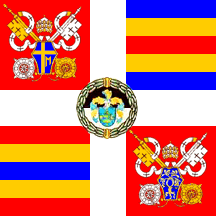
With the Arms of Guard Commandant Roland Buchs-Binz
(1982-1997)
image by António Martins-Tuválkin, 7 June 2005
The Vatican Swiss Guard regimental flag used during (part of)
John Paul II's reign, under the command of a previous colonel.
This flag differs from the (later) one we display above in the
central disc, matching a different Commander Colonel: The
background is black over white, for Fribourg
canton, and the colonel's personal arms are diferent. There are
also rendering diferences for the wreath ornament.
António Martins-Tuválkin, 7 June 2005
1997-1998 (not in official use)
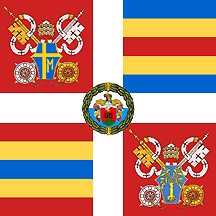
Not in official use
With the Arms of Guard Commandant Alois Estermann
image by Jens Pattke, 11 June 2005
The commander Alois Estermann was a interim-commander
colonel since November 1997. Before the day of his
murder, in May 4 1998, there was already a new flag of the Swiss
Guard. It had been already produced but not presented yet
officially. Also the flag was not consecrated yet by a cardinal
or the pope John Paul II. However, the new badge of comm. Colonel
Alois Estermann was already known to the public (See: Flag
Bulletin No. 187 (1999) ; pp. 89-105). On the 5th May, 1997 the
official job was taken over by the already resigned commander
Roland Bush-Binz. During the next day, the sacco di Roma
1998, the old Swiss Guard flag with the badge of Col.
Bush-Binz was used.
Jens Pattke, 11 June 2005
1998-2002
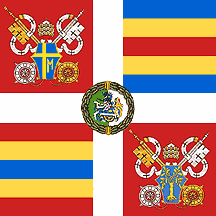
With the Arms of Guard Commandant Pius Segmüller
image by Jens Pattke, 23 January 2006
Upper hoist: arms of John Paul II. Center: Pius Segmüller, on
green-white background (for Sankt Gallen).
Source: <www.schweizergarde.info>.
Jens Pattke, 23 January 2006
2002-2005
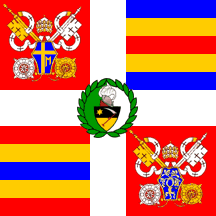
With the Arms of Guard Commandant Elmar Theodor Mäder
image by António Martins-Tuválkin, 25 April 2005
A very detailed image (and
its detail) of Swiss Guard
colors for John Paul II at <www.schweizergarde.info>,
reported by Rev. William M. Becker.
António Martins-Tuválkin, 20 April 2005
The upper hoist shows the J.P.II
arms, with the shield in the typical italian capo di
cavallo (horse head) shield shape and oversized keys. The
central arms are set on a green and white vertical bicolor disc
area, encircled in a stylized symmetrical wreath of 20 green
leaves: Ogival shield sable and or per fess a six pointed star of
the latter in dexter chief overall a scythe proper per
counter-bend. Closed helm with panache.
António Martins-Tuválkin, 25 April 2005
The other arms are the arms of Pope Julius II, who founded the
Swiss Guard in 1505. See <members.tripod.com>
located by António.
Santiago Dotor, 25 April 2005
It seems that in the photo
that we have, central arms seems to be Alois Estermann's and
papal arms Paulus VI's, which is anachronical. Can somebody
identify it?
António Martins-Tuválkin, 20 September 2005